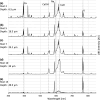The role of potassium in depth profiling of the tumor border in bone-invasive oral cancer using laser-induced breakdown spectroscopy (LIBS): a pilot study
- PMID: 37716922
- PMCID: PMC10645631
- DOI: 10.1007/s00432-023-05411-9
The role of potassium in depth profiling of the tumor border in bone-invasive oral cancer using laser-induced breakdown spectroscopy (LIBS): a pilot study
Abstract
Purpose: Microscopic tumor spread beyond the macroscopically visible tumor mass in bone represents a major risk in surgical oncology, where the spatial complexity of bony resection margins cannot be countered with rapid bone analysis techniques. Laser-induced breakdown spectroscopy (LIBS) has recently been introduced as a promising option for rapid bone analysis. The present study aimed to use LIBS-based depth profiling based on electrolyte disturbance tracking to evaluate the detection of microscopic tumor spread in bone.
Methods: After en bloc resection, the tumor-infiltrated mandible section of a patient's segmental mandibulectomy specimen was natively investigated using LIBS. Spectral and electrolytic depth profiles were analyzed across 30 laser shots per laser spot position in healthy bone and at the tumor border. For the histological validation of the lasered positions, the mandibular section was marked with a thin separating disc.
Results: Solid calcium (Ca) from hydroxyapatite and soluble Ca from dissolved Ca can be reliably differentiated using LIBS and reflect the natural heterogeneity of healthy bone. Increased potassium (K) emission values in otherwise typically healthy bone spectra are the first spectral signs of tumorous bone invasion. LIBS-based depth profiles at the tumor border region can be used to track tumor-associated changes within the bone with shot accuracy based on the distribution of K.
Conclusion: Depth profiling using LIBS might enable the detection of microscopic tumor spread in bone. In the future, direct electrolyte tracking using LIBS should be applied to other intraoperative challenges in surgical oncology to advance rapid bone analysis by spectroscopic-optical techniques.
Keywords: Bone invasion; Depth profiling; Head and neck cancer; Laser-induced breakdown spectroscopy (LIBS); Microscopic tumor spread; Potassium.
© 2023. The Author(s).
Conflict of interest statement
KOB is an employee of Advanced Osteotomy Tools AG. The other authors declare no conflict of interest.
Figures





References
-
- Chandy KG, Norton RS (2016) Channelling potassium to fight cancer. Nature 537:497–499. 10.1038/nature19467 - PubMed
-
- Del-Río-Ibisate N, Granda-Díaz R, Rodrigo JP, Menéndez ST, García-Pedrero JM (2021) Ion channel dysregulation in head and neck cancers: perspectives for clinical application. Rev Physiol Biochem Pharmacol 181:375–427. 10.1007/112_2020_38 - PubMed
-
- Eagle MJ, Rooney P, Kearney JN (2015) Development of an improved bone washing and demineralisation process to produce large demineralised human cancellous bone sponges. Cell Tissue Banking 16:569–578. 10.1007/s10561-015-9504-y - PubMed
MeSH terms
Substances
Grants and funding
LinkOut - more resources
Full Text Sources
Medical
Research Materials

